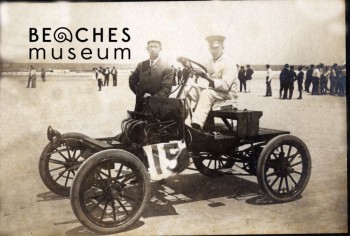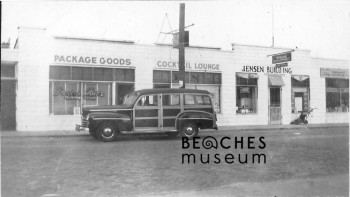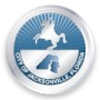Neptune was named by land speculator Eugene Gilbert in 1885. His advertisement called Neptune, “The City By The Sea”. He touted beach life and promised a hotel, railroad line and depot. Gilbert did not fulfill those promises, for a number of reasons chief amongst them a failure to sell more than 40 lots. He was persistent, however and hard work on his part and his son, Fred Gilbert, led to the construction of Atlantic Boulevard in 1910.

Mr. John E. Gilbert and another man pictured with four cylinder Franklin no. 15. Mr. Gilbert won a silver trophy for racing at 80 miles per hour
From the beginning, Neptune was technically, a part of Pablo and later, Jacksonville Beach, but it had its own distinct identity separate from the larger tourist-oriented area 2 miles south.
Neptune achieved national fame in 1922 when Lt. James L. Doolittle began his record-setting cross country flight on the beach at Neptune.
National press and successive land speculators failed to build on Gilbert’s plans. By 1924, there were only 29 cottages in Neptune. The next few years, however, saw growth and by late 1931, there were approximately 70 cottages.
The cottages were summer residences, owned largely by Jacksonville residents. Many of them were lawyers and real estate agents. In 1931, they led a movement to secede from Jacksonvllle Beach. The initial impetus was a revolt over a special tax levy. Jacksonville Beach rescinded the levy. The movement continued in large part due to resistance to Jacksonville Beach pressure for consolidation and desire for better civic services. On August 11, 1931, Neptune property owners went to the Gulf filling station on Atlantic Boulevard and voted 113-31 to separate from Jacksonville Beach.
The city leaders set out to create a city by the sea, calling it a “resort town”. They planned a business district to which they were prepared to welcome everything from Ferris wheels to bakeries, bath houses to organ grinders (with monkeys). Like their predecessors, these plans largely failed to come to fruition.

Historic Pete’s Bar – First Street Neptune Beach, 1948
In the 1940s, a few hotels/motels offered accommodations, meals, and liquor to visitors. Most people, however, made their way to Pete’s Bar on First Street. Pete Jensen moved to the beaches in the 1920s and opened a market that sold everything from live animals to moonshine. When Prohibition ended in 1933, Jensen acquired what may be the first liquor license in Duval County and opened Pete’s Bar. Still going strong over 80 years later, Pete’s Bar is a testament to longevity.
For its first 45 years, Neptune grew slowly. Even after a burst of building in the 1930s and 1940s, the town failed to attract tourists and businesses to serve them in significant numbers. Today, Neptune residents appreciate their residential community and just like Gilbert’s pioneers, live here for the beach life.



